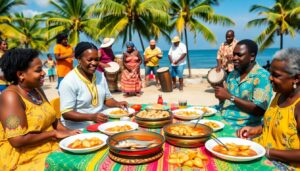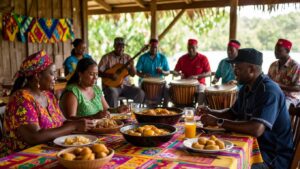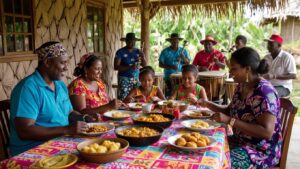Dive Deep into the Vibrant Garifuna Culture of Belize: Uncover Heritage, Culinary Treasures & Cultural Experiences
The Garifuna community of Belize embodies a rich and dynamic blend of African, Indigenous Caribbean, and European cultural influences, resulting in a cultural heritage that is both distinctive and globally celebrated, particularly recognized by UNESCO. Their extensive traditions span various elements, including language, music, culinary arts, dance, spiritual practices, and a profound sense of community. This comprehensive guide explores the fascinating narrative of the Garifuna in Belize, examining their history, cultural traditions, festivals, gastronomy, and the vibrant cultural scene in Hopkins Village.
Discovering the Rich Heritage of the Garifuna People
The Garifuna represent one of the most prominent cultural groups in Belize, with their lineage tracing back to West and Central African ancestors, as well as the Indigenous Caribs and Arawaks. Their resistance to colonial forces in St. Vincent in 1797 led to their forced exile to Central America. Today, Belize is home to around 30,000 Garifuna individuals who contribute significantly to the cultural diversity of southern Belize through their unique language, exquisite cuisine, vibrant art, and rich traditions. Recognized as a Masterpiece of the Oral and Intangible Heritage of Humanity by UNESCO, the Garifuna’s enduring creativity and resilience thrive in communities like Dangriga, Hopkins, Seine Bight, and Punta Gorda, as well as within diaspora communities across the Americas. Each year, the observance of Garifuna Settlement Day on November 19th celebrates their rich cultural narrative of resilience and community spirit.

Unraveling the Historical Roots of the Garifuna Community
Tracing the Unique Ancestry of the Garifuna People
The journey of the Garifuna people began in the 17th century through a remarkable amalgamation of African survivors from two Spanish slave ships and the Indigenous Carib and Arawak inhabitants of St. Vincent in the Lesser Antilles. Over more than 150 years, intermarriage and cultural exchanges led to the formation of a unique Afro-Indigenous identity, referred to as the Garinagu. This identity is characterized by a rich interweaving of traditions, languages, and practices that showcase their diverse ancestral origins and cultural richness.
Forced Displacement and New Beginnings in Central America
In 1797, after a fierce struggle against British colonial forces, around 5,000 Garifuna individuals were forcibly displaced from St. Vincent and relocated to Roatán, Honduras. This marked the start of migrations that would spread along the Central American coast. By the early 19th century, thriving Garifuna communities had been established in southern Belize, particularly in culturally vibrant locales such as Dangriga, regarded as the cultural capital, alongside Hopkins, Seine Bight, and Barranco. This migration was supported by British authorities, who sought skilled laborers adept in fishing and agriculture, which facilitated the growth and establishment of these communities.
Endurance and the Preservation of Cultural Practices
Despite the numerous challenges posed by European colonization, land dispossession, and systemic discrimination, the Garifuna have remarkably managed to preserve their language, social structures, and rich spiritual traditions. The establishment of the National Garifuna Council in 1981 has been instrumental in advocating for the cultural rights and education of the Garifuna people, ensuring that their invaluable heritage continues to be celebrated and acknowledged both locally and internationally.
The Role of Language and Identity in Garifuna Culture
The Distinctiveness of the Garifuna Language
The Garifuna language is an Arawakan language that is notable for its blend of Carib and African loanwords, rendering it a remarkable linguistic example among the languages of Central America. It features gendered pronouns, an intricate tense system, and a wealth of oral traditions that encapsulate the community's historical narratives and cultural ethos. However, the survival of the Garifuna language faces threats due to migration and urbanization, with fewer than 15,000 Belizean Garifuna individuals remaining fully fluent in their ancestral tongue.
Efforts for Revitalization and Preservation of Language
The recognition of the Garifuna language and music as an Intangible Heritage by UNESCO in 2001 has sparked revitalization initiatives. In communities such as Hopkins and Dangriga, primary schools have begun offering programs in the Garifuna language, while local radio stations broadcast music and news in the language, fostering its continued relevance. Organizations like GAMAE International have initiated language immersion camps aimed at reconnecting the youth with their ancestral roots and linguistic heritage.
Expressions of Identity and Global Connections
The Garifuna identity is reinforced through traditional attire, ancestral lineage, clan totems, and unique naming customs. This identity is actively nurtured by cultural associations both within Belize and in diaspora communities located in major cities such as New York, Los Angeles, and London, where they continue to celebrate and promote their vibrant heritage.
The Dynamic Landscape of Garifuna Music and Dance
Intricate Rhythms and Spiritual Connections
Garifuna music is characterized by its complex rhythmic patterns, merging traditional African polyrhythms with indigenous chants. The drums—specifically the primero (tenor) and segunda (bass)—are central to many spiritual ceremonies and celebratory gatherings. The sacred dugú ceremony, for example, features drum circles and ancestral invocations intended to heal or bless families, illustrating the profound relationship between music and spirituality within Garifuna culture.
Celebrated Dance Forms: Punta and Punta Rock
One of the most iconic Garifuna dance styles is the punta, characterized by rapid hip movements and intricate footwork, often accompanied by call-and-response singing and vibrant percussion. The contemporary evolution of this dance style, known as punta rock, has been popularized by renowned musicians such as Andy Palacio and Pen Cayetano, who fuse traditional rhythms with modern instrumentation, helping to broaden the reach of Garifuna culture to audiences worldwide.
Cultural Festivals and Community Engagement
In the lively towns of Hopkins and Dangriga, dance troupes frequently perform during cultural festivals and for visiting tourists, creating a living bridge between generations. These performances not only celebrate Garifuna heritage but also serve as a vital economic resource for the community, enhancing tourism and cultural exchange.

Understanding Garifuna Cultural Practices and Spiritual Beliefs
The Importance of the Dugú Ceremony in Garifuna Spirituality
The dugú ceremony is a significant multi-day event where extended families unite to pay tribute to the spirits of their ancestors, referred to as gubida. Led by a spiritual healer, or buyei, this ceremony encompasses music, dance, and communal feasting, all aimed at restoring harmony within families and the wider community. It emphasizes a profound respect for the land, ancestral heritage, and collective responsibilities shared among community members.
Spiritual Beliefs and Everyday Life of the Garifuna
The spiritual beliefs held by the Garifuna represent a unique blend of Catholicism intertwined with African and Arawak cosmologies. Daily life is interspersed with various rituals, including blessing new structures, rites of passage for births and deaths, as well as agricultural celebrations. Important symbols such as the conch shell, sea turtle, and cassava serve as links between households, the natural world, and ancestral spirits, reinforcing a deep connection to their heritage.
Exploring the Culinary Richness of Garifuna Gastronomy
Essential Ingredients and Signature Garifuna Dishes
The culinary landscape of Garifuna culture is deeply rooted in staple ingredients such as cassava (or yuca), plantains, coconut, and freshly caught seafood. Among traditional offerings, ereba stands out as a unique cassava bread made from grated cassava that is pressed and toasted over an open flame. Another signature dish, hudut, features fish cooked in rich coconut milk and served alongside mashed green and ripe plantains. Other beloved dishes include machuca, a hearty fish soup complemented by garlicky mashed plantain dumplings, and tapou, a savory seafood stew enriched with coconut milk. In bustling street markets in Hopkins and Dangriga, visitors can indulge in local delights such as cassava pone (a sweet cake), fried plantain balls (known as ganún), and refreshing conch ceviche.
Commitment to Sustainable Culinary Practices
Traditional Garifuna methods such as seasonal fishing, shellfish gathering, and small-scale gardening promote ecological stewardship and sustainable food practices. These traditions are guided by cultural taboos and principles of communal resource management. Culinary festivals held in Hopkins showcase cooking contests and food tours organized by women’s cooperatives, ensuring the preservation of cherished recipes and culinary techniques while inviting visitors to engage with the rich gastronomic heritage of the Garifuna community.
Hopkins Village: The Cultural Epicenter of the Garifuna Heritage
Historical Significance and Cultural Relevance of Hopkins Village
Established in the early 1800s and referred to as Yarumein in the Garifuna language, Hopkins is located along the scenic Stann Creek coast. It stands as a significant hub for the Garifuna language, music, and crafts, representing the community's rich cultural legacy and ongoing traditions.
Unique Experiences to Explore in Hopkins Village
- Drum Circles: Join daily drum workshops and enjoy nightly drum circles at local cultural centers.
- Garifuna Museum: Discover artifacts, oral histories, and photographic archives that illuminate the migration, language, and music of the Garifuna.
- Homestays and Workshops: Interact with local families offering cooking classes, fishing excursions, and demonstrations of traditional cassava bread preparation.
Annual cultural events in Hopkins, especially the youth pageants during Garifuna Settlement Day, position the village as a genuine gateway for visitors to experience the intricate cultural tapestry of Garifuna Belize.
Impact of Cultural Tourism on Local Economies
Cultural tourism is a crucial economic driver in Hopkins, supporting over 75% of local families through guest accommodations, handicrafts, music lessons, and guided tours. The headquarters of the National Garifuna Council plays a vital role in coordinating regional festivals and advocacy efforts, ensuring that Garifuna culture remains dynamic and visible on the global stage.
Garifuna Settlement Day: A Cultural Celebration of Heritage
The Historical Importance of Garifuna Settlement Day
Observed annually on November 19 since 1941 and gaining national recognition in 1977, Garifuna Settlement Day commemorates the significant arrival of Garifuna ancestors in Belize by canoe in 1802. The reenactment procession known as Yurumein features villagers arriving ashore carrying drums, cassava, and crops amidst joyous singing and prayers, symbolizing their enduring legacy and cultural heritage.
Modern Celebrations and Festivities of Settlement Day
The celebrations for Garifuna Settlement Day seamlessly blend sacred and secular elements, featuring nightlong dugú ceremonies and continuous drumming in churches and community squares. Colorful processions adorned in traditional attire, lively parades, dance performances, and culinary fairs mark this important day. National broadcasts, media features, and diaspora celebrations in major U.S. cities attract visitors from across Belize and beyond, enhancing awareness and appreciation for Garifuna cultural traditions.
Addressing Contemporary Challenges and Sustaining Cultural Heritage
Language Preservation Amidst Youth Language Shift
Language shift poses a significant threat to the Garifuna community, as many young individuals, especially in urban areas, increasingly communicate in English or Kriol at home. UNESCO has recognized this concerning trend, leading schools and NGOs to implement immersive language programs, radio broadcasts, and mentorship initiatives aimed at safeguarding linguistic heritage and cultural identity.
Land Rights and Tourism Development Concerns
The rapid growth of tourism and real estate development in coastal areas such as Seine Bight and Hopkins threatens traditional landholdings of the Garifuna people. Advocacy efforts from the National Garifuna Council and collaborative NGOs focus on securing land rights, influencing urban development, and ensuring that tourism revenues positively impact local families and communities.
Engaging Youth through Arts, Technology, and Diaspora Connections
Garifuna artists and musicians, both locally and in the diaspora, are actively involved in recording music, documenting recipes, and preserving oral histories to create digital archives and virtual festivals. These modern platforms are vital in fostering connections between the broader Garifuna community and younger generations, ensuring that their rich cultural heritage is maintained and celebrated.
Essential Guidelines for Experiencing Garifuna Culture Responsibly
- Select accommodations in Hopkins, Dangriga, or Seine Bight, and book tours directly with Garifuna-owned businesses to uplift the local economy.
- Take part in a drum workshop, attend a Settlement Day celebration, or volunteer in local cultural preservation projects to immerse yourself in the culture.
- Support women’s cooperatives by trying traditional dishes or purchasing handcrafted items to foster sustainable livelihoods.
- Respect local customs; always seek permission before taking photographs of individuals, and be considerate during rituals and ceremonies.
- Learn a few basic phrases in the Garifuna language to show respect and genuine interest in the culture.
Garifuna culture in Belize reflects a vibrant tapestry woven from resilience, profound spirituality, infectious music, delectable culinary offerings, and strong community connections. Visiting places like Hopkins or Dangriga, participating in local festivals, or immersing oneself in the rhythmic pulse of the drums offers travelers a unique opportunity to engage with a rich historical continuum where past and present resonate together. Supporting Garifuna-owned businesses, honoring their traditions, and celebrating the linguistic and culinary diversity of this remarkable culture are essential steps towards ensuring its survival and flourishing for generations to come.
References and Further Reading on Garifuna Culture
- Language, Dance and Music of the Garifuna – UNESCO Intangible Heritage
- History Of The Garifuna People – Belize.com
- Garifuna people – Wikipedia
- Varner, G.R. “Native Status and Maya Identity in Belize.” Journal of Latin American Anthropology, 1998
- Lee, N.R. “Toledo Garifuna and Indigenous Rights.” Mesoamerican Research, 2022
- National Garifuna Council – Wikipedia
- The Garifuna Living Heritage – ICH NGO Forum, 2023
- Dinther, R. “Language Shift and Prestige: Garifuna in Hopkins.” Journal of Pidgin and Creole Languages, 2017
- Habinaha Garifuna Language Program
- Veal, T. “Africanisms in Garifuna Culture of Belize.” Cultural Anthropology, 2004
- National Geographic: Preserving Garifuna Identity Through Ritual
- Music In Africa: Punta Rock and Garifuna Music
- Hopkins Cultural Center Official Site
- Cultural Survival Quarterly: Maya Rainforest and Garifuna in Belize
- Belize Living Heritage: Rituals and Social Practices
- Texas A&M: Belizean Food Culture
- Love Your Belize: Hudut Recipe
- Global M&A Pages: Sustainable Fishing Cooperatives
- National Garifuna Council of Belize
- UN Sustainable Development Reports on Garifuna Cultural Tourism
- Ambergris Caye: Garifuna Settlement Day Celebrations
- Garifuna.com: Diaspora, Digital Storytelling, and Modern Initiatives
The Article Garifuna Culture in Belize: Heritage, Food & Where to Experience It appeared first on Belize Travel Guide
The Article Garifuna Culture: Experience Heritage and Cuisine in Belize Was Found On https://limitsofstrategy.com


